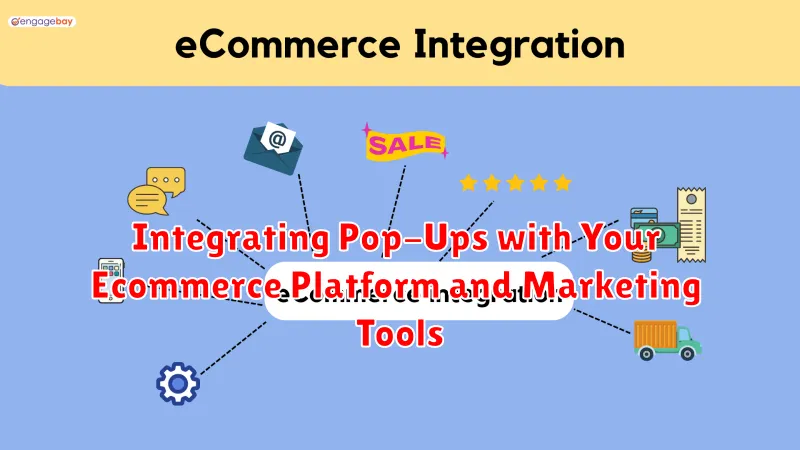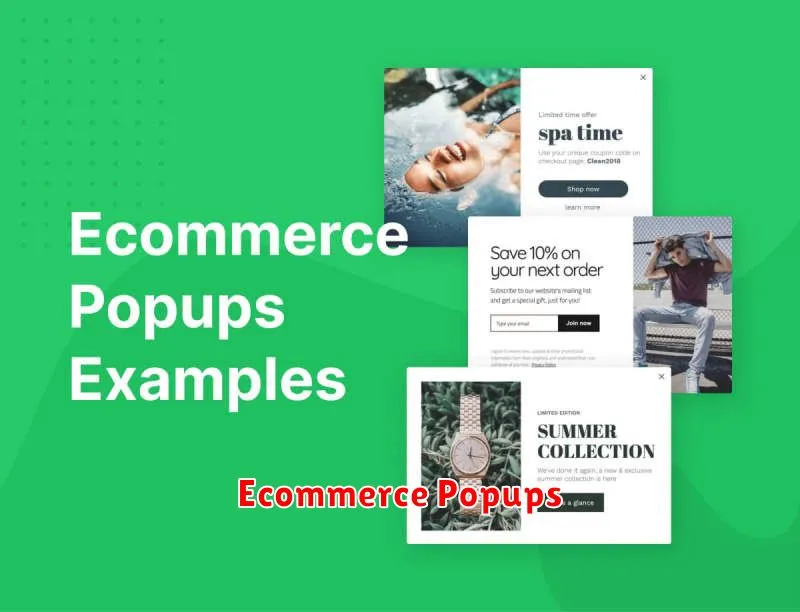Are you looking for a way to boost your sales and drive more conversions on your eCommerce store? Look no further than pop-ups! These powerful tools can help you capture attention, engage visitors, and ultimately, increase your bottom line. While the idea of pop-ups might conjure up images of annoying, intrusive ads, modern pop-up technology is far more sophisticated and effective.
By strategically deploying targeted pop-ups, you can seamlessly integrate them into your website design, offering a smooth and user-friendly experience. From enticing discount offers and free shipping promotions to compelling lead capture forms and exit-intent pop-ups, the possibilities are endless. This article will delve into the art of mastering eCommerce conversions with pop-ups, providing you with proven strategies and actionable insights to elevate your sales game.
Understanding the Power of Pop-Ups in Ecommerce
In the competitive world of e-commerce, every interaction counts. You have mere seconds to capture a shopper’s attention and convince them to take action. This is where pop-ups come in. These seemingly simple overlays can be powerful tools for boosting conversions and driving sales.
The magic lies in their ability to interrupt the user’s journey at a crucial moment, delivering targeted messages that resonate with their needs. Whether it’s offering a discount, prompting sign-ups, or showcasing a new product, well-crafted pop-ups can significantly impact your bottom line.
Think of it this way: you’re walking down a busy street, and suddenly, a vibrant banner catches your eye with a tempting offer. You stop, intrigued, and explore the opportunity. The same principle applies to pop-ups. They provide a momentary distraction from the user’s browsing experience, drawing their focus to something potentially valuable.
Strategic Timing: When to Deploy Pop-Ups for Maximum Impact
The key to successful pop-up campaigns lies in strategic timing. You want to deploy your pop-ups when your audience is most receptive, ensuring your message resonates and delivers the desired impact. Timing plays a crucial role in achieving this.
Consider these strategic timing approaches:
- Exit-Intent Pop-Ups: Triggered when a visitor attempts to leave your website, these pop-ups present a last-minute opportunity to capture their attention. Offer a discount code, free shipping, or an exclusive offer to encourage them to stay. This can be a powerful tool for reducing cart abandonment rates.
- Welcome Pop-Ups: Greet new visitors with a welcoming pop-up offering a discount or exclusive content. This can help you build trust and encourage engagement from the outset.
- Time-Based Pop-Ups: Use pop-ups that appear after a specific amount of time spent on your website. This allows you to show targeted offers based on browsing behavior. For example, if someone spends a significant time on a product page, you could trigger a pop-up showcasing related products or encouraging them to add it to their cart.
- Scroll-Based Pop-Ups: Trigger pop-ups after a user scrolls to a certain point on the page. This ensures they have already engaged with your content before being presented with a pop-up. Consider showcasing a product highlight, a newsletter sign-up, or a relevant offer.
Experiment with different timing strategies and track their performance to identify what works best for your audience. Remember, pop-ups are a tool for enhancing user experience, not interrupting it. By leveraging strategic timing, you can maximize the effectiveness of your pop-up campaigns, drive conversions, and boost your overall ecommerce success.
Types of Pop-Ups That Convert: Exit-Intent, Add-to-Cart, and More
Pop-ups are a powerful tool for ecommerce businesses to capture leads, drive sales, and enhance user engagement. By strategically implementing different types of pop-ups, you can effectively target your audience and achieve your desired outcomes. Here are some of the most effective types of pop-ups to consider:
Exit-Intent Pop-Ups
Exit-intent pop-ups are triggered when a user is about to leave your website. These pop-ups can be a great way to recapture lost customers by offering incentives such as discounts, free shipping, or exclusive content. By prompting users to stay, you can increase the likelihood of them completing a purchase or subscribing to your email list.
Add-to-Cart Pop-Ups
Add-to-cart pop-ups appear after a customer adds an item to their shopping cart. These pop-ups can be used to encourage users to complete their purchase by offering a discount on their order, suggesting related products, or reminding them of free shipping.
Welcome Pop-Ups
Welcome pop-ups are displayed when a user first visits your website. These pop-ups can be used to introduce yourself, highlight your best offers, or encourage users to subscribe to your newsletter. By engaging users from the very beginning, you can establish a positive brand impression and create a strong foundation for a successful interaction.
Time-Based Pop-Ups
Time-based pop-ups appear after a certain amount of time has passed on your website. These pop-ups can be used to offer limited-time discounts, highlight seasonal promotions, or provide valuable information to your users. By utilizing time-based triggers, you can ensure that your pop-ups are relevant and timely, increasing their effectiveness.
Scroll-Based Pop-Ups
Scroll-based pop-ups are triggered when a user scrolls down a specific portion of your website. These pop-ups can be used to offer discounts or free shipping on specific product categories, display related products or services, or gather feedback from users. By targeting your pop-ups to specific sections of your website, you can deliver highly relevant and targeted content to your audience.
By experimenting with different types of pop-ups and tracking your results, you can identify the most effective strategies for your business. By utilizing pop-ups strategically, you can boost your sales, enhance user engagement, and build lasting relationships with your customers.
Crafting Compelling Pop-Up Copy That Drives Action
Pop-ups can be a powerful tool for driving conversions on your ecommerce website, but only if they’re crafted with compelling copy that captures attention and compels visitors to take action. Here’s how to write pop-up copy that converts:
1. Be clear and concise: Get straight to the point. Tell visitors exactly what you want them to do and why they should do it. Don’t waste their time with long, rambling messages.
2. Highlight the benefit: Focus on what the visitor will gain by taking action, not just what you’re offering. For example, instead of saying “Sign up for our email list,” say “Get exclusive discounts and early access to new products by signing up for our email list.”
3. Create urgency: Use words like “limited time,” “exclusive offer,” or “don’t miss out” to create a sense of urgency and encourage visitors to act quickly.
4. Use strong calls to action: Make it clear what you want visitors to do. Use strong, action-oriented verbs like “Shop Now,” “Download Now,” or “Claim Your Discount.”
5. Test and refine: Don’t be afraid to experiment with different copy and headlines. Track your results and make adjustments as needed to optimize your pop-ups for maximum conversions.
By following these tips, you can create pop-up copy that captures attention, drives action, and boosts your ecommerce conversions. Remember, the key is to focus on providing value to your visitors and making it easy for them to take advantage of your offers.
Designing Visually Appealing Pop-Ups That Capture Attention

In the bustling online landscape, capturing attention is crucial, especially when trying to drive conversions. Pop-ups, when strategically designed, can be potent tools for achieving this. A visually appealing pop-up is more than just a box with text; it’s an opportunity to engage users and make a lasting impression.
Here are some key elements to consider when designing your pop-ups:
Color Psychology:
The colors you choose can evoke emotions and influence user behavior. A bright, bold color can grab attention, while a softer hue can create a sense of calm. Consider your brand colors and the message you want to convey.
Typography:
The font you select should be readable and consistent with your brand’s identity. Avoid overly decorative fonts that can be difficult to read. Keep the text concise and focus on the call to action.
Images and Graphics:
A compelling image or graphic can enhance the visual appeal of your pop-up. Choose images that are relevant to your offer and high-quality. Avoid cluttered images that distract from the message.
White Space:
Don’t overcrowd your pop-up. Allow for ample white space to make the design breathable and easy on the eyes. This improves readability and gives the content room to breathe.
Clear Call to Action:
The purpose of your pop-up is to guide users towards a specific action. Make your call to action prominent and easy to understand. Use strong verbs and clear language to encourage engagement.
Remember, design is about creating a positive user experience. By paying attention to these elements, you can craft visually appealing pop-ups that resonate with your audience and contribute to your conversion goals.
Personalization and Segmentation: Delivering Relevant Pop-Up Experiences

In the world of e-commerce, where competition is fierce, captivating your audience and driving conversions is paramount. Pop-ups, when strategically implemented, can be a powerful tool to achieve this goal. However, simply throwing up generic pop-ups won’t cut it. To truly boost your sales, you need to personalize and segment your pop-up experiences, ensuring each visitor receives relevant offers tailored to their individual needs.
Personalization involves delivering content that resonates with individual users. This can be achieved by leveraging data points like browsing history, purchase history, and even demographic information. For example, if a customer has viewed a specific product category multiple times, you can trigger a pop-up offering a discount or highlighting related items. This targeted approach increases engagement and conversion rates.
Segmentation, on the other hand, focuses on categorizing your audience based on shared characteristics. This could include demographics, interests, behaviors, or even their stage in the customer journey. For instance, you can segment first-time visitors with a welcome pop-up offering free shipping or a discount on their first purchase. For returning customers, you might display a pop-up highlighting exclusive deals or new products they might be interested in.
By combining personalization and segmentation, you can create highly relevant pop-up experiences that drive conversions. Imagine a first-time visitor who’s shown a pop-up showcasing a free shipping offer on a specific product they’ve been browsing. This targeted approach increases the likelihood of a purchase, leading to higher conversion rates.
Remember, pop-ups are a valuable tool, but only if they are strategically implemented. By focusing on personalization and segmentation, you can create relevant experiences that engage your audience and boost your sales. The key is to ensure that your pop-ups add value and don’t interrupt the user experience. When done right, pop-ups become a powerful force in driving conversions and achieving your e-commerce goals.
A/B Testing Your Pop-Ups for Continuous Improvement
Pop-ups are a powerful tool for driving conversions, but they’re only effective if they’re optimized for your target audience. A/B testing is a crucial element of optimizing your pop-ups and ensuring they achieve their goals. A/B testing allows you to experiment with different variations of your pop-up and identify the elements that resonate best with your audience.
Here are a few key elements you can test:
- Trigger: Experiment with different triggers for your pop-ups, such as exit-intent, timed delays, or scroll depth. Observe which triggers perform best and lead to more conversions.
- Design: Test different colors, fonts, layouts, and visuals to see which ones attract more attention and drive engagement.
- Offer: Analyze the effectiveness of different offers, such as discounts, free shipping, or exclusive content.
- Call to Action: Optimize your calls to action by experimenting with wording, button colors, and placement.
By implementing A/B testing, you can gain valuable insights into what works best for your audience and continuously refine your pop-up strategy to maximize conversions and drive your ecommerce business forward.
Measuring Success: Key Metrics for Pop-Up Optimization
While pop-ups can be powerful tools for driving conversions, their effectiveness hinges on proper optimization. Simply throwing up a pop-up and hoping for the best won’t cut it. You need to track key metrics to understand what’s working and what’s not, allowing you to fine-tune your strategy for maximum impact.
Here are some essential metrics to monitor:
- Conversion Rate: This is the percentage of visitors who take the desired action, like signing up for a newsletter or making a purchase, after interacting with your pop-up. A higher conversion rate indicates a more effective pop-up.
- Click-Through Rate (CTR): This measures how many users click on your pop-up’s call-to-action. A high CTR suggests your pop-up is capturing attention and enticing users to engage.
- Exit Intent Rate: This metric tracks how often users attempt to leave your site and are then presented with your pop-up. If a large percentage of users are leaving, it might indicate that your pop-up is interrupting their browsing experience.
- Average Time Spent on Page: Observe how long users spend on the page before and after encountering the pop-up. A decrease in time spent could suggest a disruptive experience.
- Bounce Rate: Track whether users bounce from your page after interacting with the pop-up. A high bounce rate might signal an ineffective or disruptive pop-up experience.
By closely monitoring these metrics, you can gain valuable insights into the performance of your pop-up campaigns. This data allows you to make informed decisions about your pop-up strategy, ensuring they are driving conversions and delivering a positive user experience.
Avoiding Common Pop-Up Mistakes That Hinder Conversions
Pop-ups can be a powerful tool for boosting your eCommerce conversions, but only if used correctly. If you’re not careful, they can be annoying and drive customers away. Here are a few common mistakes to avoid:
1. Using too many pop-ups: Bombarding your visitors with too many pop-ups can be overwhelming and frustrating. It’s best to stick to one or two pop-ups per session, and only use them for relevant offers.
2. Not timing your pop-ups correctly: Showing a pop-up right when a visitor arrives on your site or just before they’re about to checkout can be disruptive. Instead, use exit-intent pop-ups or time your pop-ups to appear after a certain amount of time on the site.
3. Offering irrelevant or low-value offers: Make sure the offers in your pop-ups are aligned with your visitors’ interests and needs. A discount on a product they’re not interested in won’t do anything for your conversion rate.
4. Using a poor design: Pop-ups should be visually appealing and easy to use. Avoid using too many colors or fonts, and make sure the call-to-action is clear and concise.
5. Not testing your pop-ups: It’s crucial to test different pop-up variations to see what works best for your audience. Experiment with different timings, offers, and designs to optimize your results.
By avoiding these common mistakes, you can create pop-ups that are effective and don’t hinder your conversions. Remember, the key is to provide value to your visitors and make the pop-up experience as seamless and enjoyable as possible.
Best Practices for GDPR Compliance with Pop-Ups
Pop-ups can be powerful tools for boosting ecommerce conversions, but they can also pose privacy concerns. With the General Data Protection Regulation (GDPR) in place, it’s crucial to ensure your pop-ups are compliant to avoid penalties and maintain user trust. Here are some key best practices to help you achieve GDPR compliance with your pop-ups:
1. Transparency and Consent: Be transparent about why you’re collecting data and how it will be used. Clearly state your purpose for collecting data in your pop-up message and ensure users can easily understand the terms. Implement a clear opt-in mechanism where users actively consent to data collection.
2. Clear and Concise Language: Use simple and understandable language in your pop-up messages. Avoid legal jargon and technical terms that may confuse users. Clearly explain what data you’re collecting and why.
3. Legitimate Interest: If you’re relying on legitimate interest as the legal basis for data processing, clearly explain how your pop-up serves this interest. This could involve providing personalized recommendations, improving website usability, or offering relevant promotions.
4. Data Minimization: Only collect the essential data needed to achieve your stated purpose. Don’t over-collect data that isn’t relevant to your pop-up’s objective.
5. User Control: Provide users with the ability to control their data. Offer an easy way for them to opt out of data collection or modify their preferences. Make it clear how users can access, correct, or delete their data.
6. Security and Storage: Ensure your pop-up forms and data storage comply with GDPR security requirements. Implement robust security measures to protect user data from unauthorized access, breaches, and loss.
By following these best practices, you can ensure your pop-ups are GDPR compliant and protect your users’ privacy while effectively leveraging pop-ups for your ecommerce conversions.
Integrating Pop-Ups with Your Ecommerce Platform and Marketing Tools

Pop-ups are a versatile tool that can be integrated seamlessly with your ecommerce platform and marketing tools to boost conversions. When strategically implemented, they can capture leads, promote special offers, and increase your website’s engagement.
To effectively integrate pop-ups, consider these key aspects:
Ecommerce Platform Integration
Most popular ecommerce platforms, such as Shopify, WooCommerce, and BigCommerce, offer built-in pop-up features or integrate with dedicated pop-up apps. Explore your platform’s options to find the best fit for your needs. Alternatively, utilize third-party pop-up tools that are compatible with your platform. Ensure the chosen tool offers customization options to match your brand’s aesthetics and effectively target your audience.
Marketing Tool Integration
Connect your pop-ups with your existing marketing tools for enhanced targeting and automation. For instance, integrate with your email marketing platform to capture leads and grow your subscriber list. You can also utilize pop-ups to display personalized offers based on customer behavior tracked through your marketing automation tools. This level of personalization can significantly improve the effectiveness of your pop-ups.
Triggering and Targeting
To maximize the impact of pop-ups, leverage triggering and targeting strategies. Triggering refers to the event that prompts the pop-up to appear, such as exit intent, time spent on page, or scroll depth. Targeting allows you to segment your audience based on demographics, browsing history, or purchase behavior. By combining triggers and targeting, you can ensure your pop-ups reach the right audience at the optimal time.
Content Optimization
Create compelling and relevant pop-up content that resonates with your target audience. Highlight value propositions, enticing offers, and clear calls to action. Ensure your pop-ups are mobile-friendly and visually appealing to maintain a seamless user experience across all devices. Keep the content concise, focusing on the key message you want to deliver.
By integrating pop-ups with your ecommerce platform and marketing tools, you can unlock their full potential to drive conversions and boost your overall sales. Remember to test different approaches, analyze results, and optimize your pop-up campaigns for continuous improvement.
Case Studies: Ecommerce Businesses Thriving with Pop-Up Strategies

Pop-ups aren’t just annoying distractions – they can be powerful tools to boost conversions and drive sales for ecommerce businesses. Let’s delve into some real-world examples of companies using pop-ups effectively.
Case Study 1: Birchbox
This beauty subscription service leverages pop-ups for lead generation. They offer a tempting discount code for visitors who sign up for their email list, converting casual browsers into loyal subscribers. By providing valuable content and exclusive deals, Birchbox fosters customer relationships and increases sales.
Case Study 2: GoDaddy
The web hosting giant uses pop-ups to encourage website visitors to upgrade their plans. With targeted messaging based on user behavior, GoDaddy presents relevant offers at the right time. This strategy ensures users are aware of the full range of services and increases the potential for higher-value purchases.
Case Study 3: Etsy
Etsy, the online marketplace for handmade goods, utilizes pop-ups to promote its curated collections. By showcasing unique and popular products, Etsy encourages browsing and sparks a sense of urgency. This strategy not only increases product visibility but also promotes sales through its intuitive design.
These are just a few examples of how successful ecommerce companies use pop-ups to their advantage. By leveraging strategic placement, targeted messaging, and compelling incentives, businesses can transform pop-ups from annoyances into powerful sales tools.

